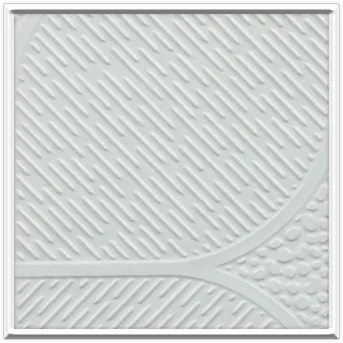Dec . 09, 2024 15:16 Back to list
difference between gypsum and pvc ceiling
Difference Between Gypsum and PVC Ceiling
When it comes to choosing materials for false ceilings, both gypsum and PVC (Polyvinyl Chloride) are popular options that present unique characteristics and benefits. Understanding the differences between these two materials can help homeowners, builders, and interior designers make informed decisions tailored to specific needs and preferences.
Composition and Structure
Gypsum ceilings are made from gypsum boards, which are composed of a mineral called calcium sulfate dihydrate. These boards are typically sandwiched between layers of paper. The boards are either finished with a smooth surface or with a textured surface, making them adaptable for different aesthetic applications. The primary structure of gypsum ceilings gives them strength and durability, making them suitable for various architectural designs.
On the other hand, PVC ceilings are made from a type of plastic polymer known for its light weight and flexibility. PVC ceiling panels often come in a variety of finishes, including glossy, matte, or textured, and can mimic the appearance of wood, metal, or ceramic. Their lightweight nature and easy installation process make them an attractive option for many homeowners.
Installation Process
The installation process for gypsum ceilings is more labor-intensive compared to PVC ceilings. Gypsum boards require framing and a joint treatment process, which includes taping, mudding, and sanding to achieve a smooth surface. This process typically takes longer and requires skilled labor to ensure quality results.
In contrast, the installation of PVC ceilings is simpler and usually faster. The panels can be directly fastened to the existing ceiling structure without the need for extensive preparation. This ease of installation reduces labor costs, making PVC a budget-friendly option for many projects.
Cost Considerations
When comparing costs, PVC ceilings are generally less expensive than gypsum ceilings in terms of material and installation. The lower overall cost, along with the reduced labor time required for installation, makes PVC a budget-friendly choice for various applications. However, it is important to consider long-term costs, including maintenance and durability over time.
difference between gypsum and pvc ceiling

Gypsum ceilings, while initially more costly, can offer better longevity and durability
. Depending on the project specifications, the initial investment in gypsum may pay off in terms of longer-lasting quality, especially in areas with high humidity where PVC may warp or sag over time.Aesthetic Appeal
Both gypsum and PVC ceilings offer aesthetic flexibility, but they cater to different design preferences. Gypsum ceilings can achieve a more sophisticated, classic look with the ability to incorporate intricate designs and moldings. They can be painted or finished in various ways to fit the desired décor, making them suitable for premium residential or commercial spaces.
PVC ceilings come in a wider array of colors and patterns, making them suitable for modern and contemporary designs. The reflective surfaces of glossy PVC panels can enhance the light in a room and create an illusion of depth. This characteristic makes them a popular choice for residential projects, particularly in spaces like kitchens and bathrooms.
Fire Resistance and Safety
An important factor to consider when evaluating ceiling materials is fire resistance. Gypsum board has inherent fire-resistant properties, as it can withstand high temperatures and delay the spread of flames. This feature makes gypsum ceilings a safer choice in areas where fire safety is a top concern.
PVC ceilings, while generally safe, do not have the same level of fire resistance. High-quality PVC products may have certain fire-retardant properties, but they cannot match the performance of gypsum in this area. This aspect is critical for commercial applications or installations in multi-story buildings where fire safety regulations need strict adherence.
Conclusion
In summary, when deciding between gypsum and PVC ceilings, several factors need to be considered, including installation ease, cost, aesthetic appeal, and safety features. Gypsum ceilings excel in durability and fire resistance, while PVC ceilings offer cost-effectiveness, faster installation, and a variety of visual styles. Ultimately, the choice will depend on individual project requirements, budget limitations, and personal design preferences. Understanding the strengths and weaknesses of each material can guide you towards making the best decision for your ceiling needs.
-
Durable Ceiling T Grid Systems | Easy InstallationNewsAug.29,2025
-
PVC Gypsum Ceiling: Durable, Laminated Tiles for Modern SpacesNewsAug.28,2025
-
Pvc Gypsum Ceiling Is DurableNewsAug.21,2025
-
Mineral Fiber Board Is DurableNewsAug.21,2025
-
Ceiling Tile Clip Reusable DesignNewsAug.21,2025
-
Ceiling T Grid Modular DesignNewsAug.21,2025







